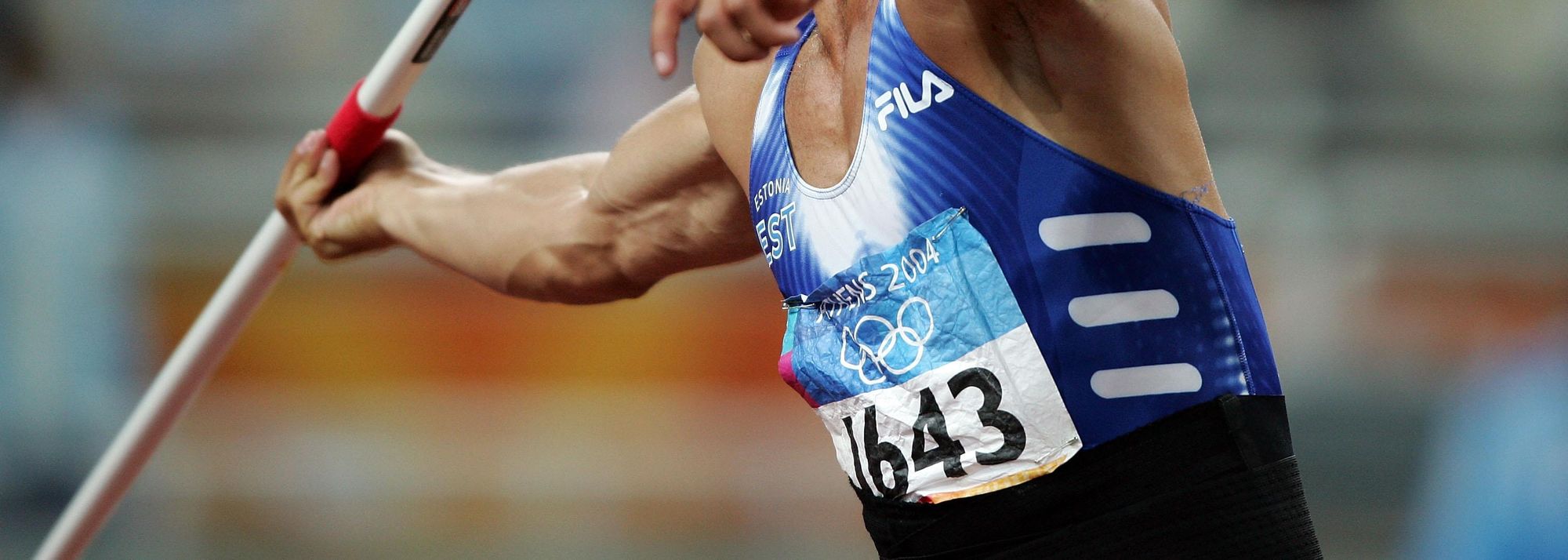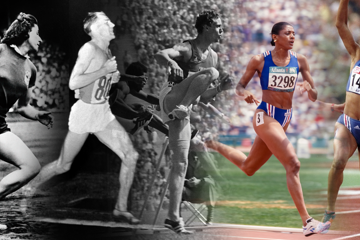Estonian decathlete Erki Nool (© Getty Images)
Estonia is one of four World Athletics federations celebrating its centenary in 2020, having been officially founded on 21 January 1920.
However, our sport was flourishing in the Baltic country for a good 40 years before the federation came into being with history showing that a variety of running races and other athletics events, notably throwing, took place at folk festivals during the final quarter of the 19th century when the country was still under Russian rule.
Several Estonian athletes were part of the 35-stong Russian Empire team that contested the Stockholm 1912 Olympic Games although no one returned with a medal.
However, domestically, Estonian athletes did have a major impact in Tsarist Russia during the decade before the country declared independence in 1918.
An early hero was Juri Lossman who, after an early career as a keen football player, joined an athletics club in 1913 at the age of 22 and then won numerous Russian titles and set national distance running records before independence despite being wounded in World War I.
Wearing the flag of Estonia on his while singlet, Lossman took the silver medal at the Antwerp 1920 Olympic Games in the marathon, finishing just 13 seconds down on the legendary Finn Hannes Kolehmainen to become his country’s first ever Olympic medallist in any sport.
Aleksander Klumberg didn’t get on the podium in Antwerp – finishing fifth in the javelin and eighth in the pentathlon – but he became Estonia’s first world record-holder when the first official decathlon world record was ratified in 1922 and won a bronze medal in this event at the Olympics in Paris two years later.
Viiding takes inaugural European shot put title
Estonian athletics then entered a fallow period in the Olympic arena with no more medals and only small teams sent for the next three Games, usually due to a lack of finances.
There were, however, some moments to savour at the first two European Championships in 1934 and 1938 before a dark cloud descended on the country during World War II with the successive occupations by Nazi Germany and then the Soviet forces.
Arnold Viiding took the shot put title at the inaugural edition of the continental championships in 1934 although he was off-form and a disappointing eighth at the 1936 Olympic Games when his national record of 16.06m that summer would have got him among the medals.
By the 1938 European Championships, Aleksander Kreek had taken over as Estonia’s top putter and he followed in the footsteps of Viiding by winning the gold medal in Paris.
In the French capital, Kreek also defeated the three men who had won the medals in Berlin two years earlier, who finished immediately behind him in second, third and fourth, as well as defeating in the weeks before Paris the newly-minted US champion Frank Ryan.
Sadly, Kreek – who improved the Estonian record to 16.40m in 1940 – had his dreams of Olympic glory destroyed by World War II but his grandson Adam Kreek was to win three rowing world titles and a gold medal for Canada at the Beijing 2008 Olympic Games.
Lipp begins strong combined events tradition
Decathlete Heino Lipp might well have been Estonia’s first Olympic athletics gold medallist as his results from the Soviet Union suggested he could potentially have challenged the eventual winner Bob Mathias at the 1948 Olympics in London. Lipp also set six European shot put bests between 1947-51, but he was deemed ‘suspect’ by the KGB and never allowed to travel internationally.
Some small compensation came when he was invited to be the Estonian flag bearer at the 1992 Olympic Games immediately after independence.
However, with the Soviet Union returning to Olympic competition in 1952, it was almost inevitable that some Estonians would be part of their teams and the most prominent among those representing the USSR in this era was the race walker Bruno Junk.
Junk won bronze in the 10,000m race walk in Helsinki, given the same time as the silver medallist, and he finished third in the 20km race walk four years later when the USSR took a sweep of the medals in this event.
He set a 15km race walk world record in 1951 and several world bests. After he retired in 1959, Junk moved into coaching and administration and was president of the Estonian athletics federation from 1979-87.
The 1950s also featured Estonian women in the USSR teams, including Virve Roolaid who took the 1954 European javelin silver medal. She remains the only Estonian woman to win a global or continental individual outdoor medal.
Estonia has a very proud tradition in combined events, which stretches back to Klumberg and continues to this day, and in the 1960s the torch was carried by Rein Aun, who was the surprise 1964 Olympic Games decathlon silver medallist and just 45 points away from gold.
Tarmak and Uudmae take Olympic gold
Finally, an Estonian athlete won an Olympic gold, albeit in the red vest of USSR, when Juri Tarmak won the Munich 1972 Olympic Games high jump title, the last male staddle jumper to triumph at the Olympics.
Eight years later, Jaak Uudmae became the Moscow 1980 Olympic Games triple jump champion.
The competition has become infamous for some highly questionable judging by the local officials but no blame could be attached to Uudmae who bounded out to a distance of 17.35m in the third round, which is still an Estonian record more than 40 years later.
Nool first star post-independence
In the years following Estonia’s return to independence in 1991 again it was a combined events competitor, Erki Nool, who was the flag bearer for Estonian athletics in this era.
Nool won heptathlon gold at the 1996 European Indoor Championships, silver in the heptathlon the following year at the World Indoor Championships – and a silver in 1999 – and in 1998 won his first major outdoor title with victory in the European Championships decathlon.
After suffering a disastrous 1999 World Championships, where he had failed to clear a height in the pole vault, usually one of his strongest events, Nool went to Sydney for his third Olympics as a likely medal contender but was far from the favourite.
In the end, the 30-year-old Nool emerged as the first Olympic athletics champion to wear an Estonian vest after a tense but exciting competition in which just 46 points covered the three medallists, another below-par performance in the pole vault compensated for by personal bests in the shot put and 1500m.
In the past two decades, the spotlight has again been on Estonia’s historic strength in the throws.
Discus thrower Gerd Kanter followed up his 2007 world title with gold at the Beijing 2008 Olympic Games and became, to date, the only Estonian athlete to win two Olympic medals when he finished third in London four years later.
In addition to his titles, Kanter has another four medals of other hues to his name from both the World Championships and European Championships.
Andrus Varnik won the world javelin title in 2005 while Magnus Kirt almost emulated him with a silver medal at last year’s World Championships – with Maicel Uibo also taking a silver in the decathlon in Doha.
Estonian athletes have shown in the 21st century that a country of little more than 1.3 million people can punch above its weight in world athletics.
Phil Minshull for World Athletics Heritage






